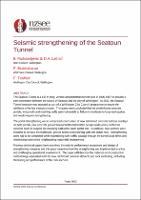Seismic strengthening of the Seatoun Tunnel

Download
Date
2022-04-27Authors
Wymer, Paul
Latham, Dean
Radosavljevic, Bojan
Brabhaharan, Pathmanathan
Tawfeek, Faiz
Metadata
Show full item recordAbstract
The Seatoun tunnel is a 147m long, vehicle and pedestrian tunnel built in 1906-1907 to provide a tram connection between the suburb of Seatoun the city of Wellington. In 2011, the Seatoun tunnel structure was assessed as part of a Wellington City Council programme to ensure the resilience of its key transport routes. The assessment concluded that the unreinforced concrete portals, wing walls and retaining walls were vulnerable to failure in moderate to large earthquakes and would require strengthening.
The portal strengthening works comprised construction of new reinforced concrete buttresses on both portals, new concrete ground beams hidden behind the parapet walls and a reinforced concrete beam to support the retaining wall at the south portal end. In addition, rock anchors were installed to tie back the buttresses, ground beams and retaining wall into stable rock. Strengthening work had to be completed while maintaining safe traffic passage through the tunnel at all times and minimising noise to the neighbouring residential environment. Previous technical papers have examined the seismic performance assessment and design of strengthening measures and this paper examines how the strengthening was implemented in a live and challenging operational environment. The paper will describe the materials and construction methodology associated with the new reinforced concrete elements and rock anchoring, including the testing and performance of the rock anchors. The work was completed in 2020 and the result is an important and vital community infrastructure asset successfully strengthened and restored to a high standard of safety and earthquake resilience.
